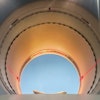A new study from the National Academy of Sciences concluded that no technical barriers exist for converting medical isotope-producing nuclear reactors from high-enriched uranium (HEU) to low-enriched uranium (LEU) for the production of molybdenum-99 (Mo-99). Chronic shortages might still persist in Mo-99 supply, however, even if such a conversion occurs.
The primary obstacle, the 186-page document concludes, is the lack of incentives or mandates for the nuclear industry to convert.
"The industry has had no incentive to convert under the current laws and policies of the U.S. and probably won't convert until made to convert," said study chairman Chris Whipple in an interview with Auntminnie.com. He added that the study saw no technical difficulty with an LEU conversion strategy and such conversions would not adversely affect a reliable supply of medical isotopes to the U.S.
Tc-99m and Mo-99
The most widely used medical isotope used in the U.S. is technetium-99m (Tc-99m). It is produced by irradiating HEU targets in a reactor, extracting Mo-99 from the targets, and collecting the Tc-99m that is produced when Mo-99 decays. Mo-99 currently is not produced in the U.S. for medical purposes.
The U.S. supply of Mo-99 originates at the National Research Universal Reactor in Chalk River, Ontario, operated by Atomic Energy of Canada (AECL), and the High Flux Reactor in Petten, Netherlands, operated by the Nuclear Research and Consultancy Group (NRCG).
Even as the committee was compiling its data over the last two-plus years, both the AECL's Chalk River reactor and NRCG's Petten facility went offline for repair. Chalk River is once again operating, but the Petten reactor is expected to be down at least until February and possibly longer.
The fact that both facilities are more than 40 years old prompted study authors to write the that the "greatest single threat" to a reliable supply of medical isotopes to the U.S. is "the approaching obsolescence of the aging reactors of current large-scale medical isotope producers."
"We have old, tired reactors and we need to bring new sources online. There is no reason at this point to think about bringing on new sources using HEU," said Whipple, who also is a principal at Environ, a global environmental consulting firm in Emeryville, CA. "The harder problem for reliability is: Can we get new sources online between now and the time that either [Chalk River] or [Petten] is shut down for good? If we cannot, we are in a lot of trouble in regard to continuing shortages."
Based on that scenario, the U.S. supply of Mo-99 is "likely to be unreliable until newer production sources come online," the authors wrote.
Supply and demand
As of 2006, the demand for Mo-99 in the U.S. was between 5,000 and 7,000 six-day curies per week. The report stated that the level of supply and demand "probably has not changed appreciably" since then, but U.S. demand for Mo-99 and Tc-99m is likely to increase 3% to 5% over the next five years. That growth also will likely continue in the years ahead, as the U.S. population ages.
The demand for Mo-99 and Tc-99m, the report noted, "will depend strongly on whether other diagnostic imaging modalities find widespread use in the U.S., which is unlikely to happen in the foreseeable future." And, without new reliable supplies of Mo-99 for medical use, supply reliability "is likely to continue to be a serious problem for the U.S. in the early part of the next decade."
The report concluded that although the conversion from HEU to LEU would help eliminate uncertainties about the availability of HEU to produce Mo-99, that strategy alone would fall short of solving supply reliability concerns associated with current HEU-based production. In addition, it would take "several years for substantial supplies from [foreign and domestic] producers to become available."
Top suppliers
Between 95% and 98% of the world's supply of Mo-99 is produced by only four entities: MDS Nordion of Ottawa, Ontario, Canada; Mallinckrodt, a division of Covidien of Hazelwood, MO; Institut National des Radioéléments in Fleurus, Belgium; and Nuclear Technology Products, a subsidiary of the South African Nuclear Energy Corp., based in Pretoria, South Africa. All four organizations use HEU targets.
MDS Nordion and Mallinckrodt currently supply all of the Mo-99 used in the U.S., distributing more than 1,000 six-day curies of Mo-99 per week. They also purchase Mo-99 from each other and from two other large-scale producers to help maintain supply reliability.
According to the report, MDS Nordion provides approximately 60% of the U.S.'s Mo-99 supply and approximately 40% of the world supply. The company acquires Mo-99 from the AECL under a revenue-sharing agreement. The targets are processed at the AECL's Chalk River reactor.
Mallinckrodt produces approximately 40% of the U.S. supply and approximately 25% of the world supply. Production is based at the Petten nuclear reactor in a joint venture with the NRCG.
Reliable supplies
The authors noted that the conversion of Mo-99 production from HEU to LEU would increase the reliability of Mo-99 supplies by removing longer-term uncertainties associated with the continued availability of HEU for Mo-99 production.
However, Mo-99 production using LEU targets could utilize the same reactors and the same or similar processing facilities used for current HEU-based production. LEU conversion also could lead to supply reliability problems if not carried out in a technically sound manner.
The use of LEU-targeted Mo-99 has been successful in one case and soon will be implemented in another. The Comisión Nacional de Energía Atómica in Argentina currently is manufacturing medical isotopes with LEU, while the Australian Nuclear Science and Technology Organisation reactor soon will come online.
The report recommends that producers and the U.S. government consider several steps to improve the feasibility of conversion. The steps include Mo-99 producers committing to the LEU conversion, implementing an LEU-based Mo-99 production process, and identifying additional needs for technical assistance.
In addition, the U.S. Department of Energy should make its technical expertise available to assist producers with conversion-related R&D and examine options to share R&D costs with those producers, incentivize the conversion process, and encourage domestic production.
By Wayne Forrest
AuntMinnie.com staff writer
January 15, 2009
Related Reading
NRCG reactor will be down longer, December 22, 2008
Belgium to restart medical isotope production, November 5, 2008
Dutch reactor won't restart until February 2009, October 15, 2008
Dutch reactor opening delayed another month, September 19, 2008
Dutch reactor down two more months, September 8, 2008
Copyright © 2009 AuntMinnie.com




















